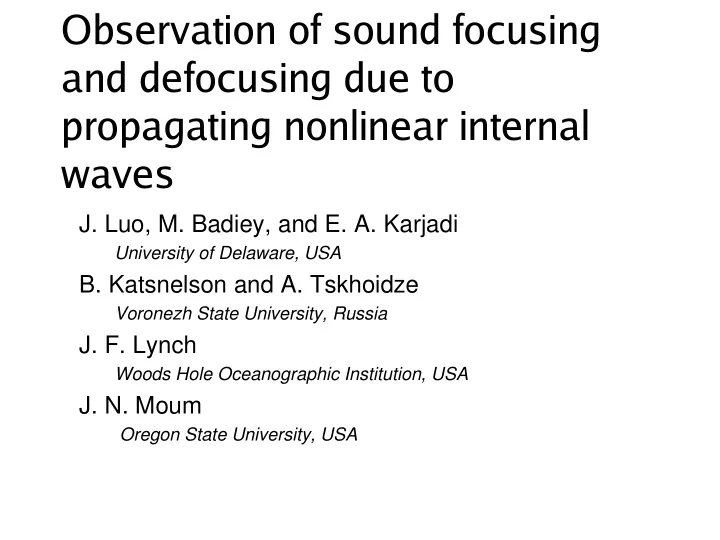

Observation of sound focusing and defocusing due to propagating nonlinear internal waves J. Luo, M. Badiey, and E. A. Karjadi University of Delaware, USA B. Katsnelson and A. Tskhoidze Voronezh State University, Russia J. F. Lynch Woods Hole Oceanographic Institution, USA J. N. Moum Oregon State University, USA
Fluctuations of the low frequency sound field in the presence of an internal solitary wave packet during the Shallow Water '06 (SW06) experiment are analyzed. Acoustic, environmental, and on-board ship radar image data were collected simultaneously before, during, and after a strong internal solitary wave packet passed through the acoustic track. Preliminary analysis of the acoustic wave temporal intensity fluctuations agrees with previously observed phenomena and the existing theory of the horizontal refraction mechanism, which causes focusing and defocusing when the acoustic track is nearly parallel to the front of the internal waves [JASA,122 (2), pp.747-760, 2007]
Acoustic source (NRL 300Hz) was located 72 m below the sea surface and 10.5 m above the sea floor, and transmitted 2.0489 second LFM signals from 270 to 330 Hz every 4 seconds. Transmissions continued for 7.5 minutes and then repeated every half hour. A vertical and horizontal receiver array (the “Shark VHLA”) on mooring SW54 was located about 20.2 km south of the NRL source. The vertical part of the receiver array consisted of 16 hydrophones with 3.5 m spacing and was positioned in the water column from 13.5 m to 77.75 m below the surface. The horizontal part of the array consisted of 32 hydrophones on the seafloor with spacing of 15 m, providing 478 m of horizontal aperture. The sampling rate of the array was 9765.625 Hz. The water depth along the acoustic track was about 80 m.
SW06 3-D View
Tracks of R/V Sharp (blue curve) and R/V Oceanus (red curve) following ISW train from 18:00 GMT on August 17 to 02:00 GMT on August 18, 2006. Left panel shows position of ISW for 20:30 GMT, right panel – 22:00 GMT
We discuss two situations: (1) when the ISW packet had not reached the acoustic track [time period Tg1 (20:30 to 20:37 GMT)] and (2) when the ISW occupied most of the acoustic track [time period Tg2 (22:00 to 22:07 GMT)]. Temperature records source midpoint receiver
Received acoustic intensity on the Shark VHLA within the Tg1 and Tg2 periods. Upper panels shows the acoustic field on the VLA portion of the array while the lower panel shows the HLA portion. (b)Tg = 20:30:16 GMT, (b) Tg = 20:31:58 GMT, (c)(c) Tg = 22:04:54 GMT, (d) Tg = 22:06:37 GMT.
Received acoustic intensity during a 440 sec (~ 7.33 mins) transmission period for two geotimes, Tg1 and Tg2: Tg1 (b) depth distribution of total intensity per pulse I(z,T) for Tg1, (c) depth integrated intensity, I(T) for VLA, (d) total intensity I(x,T) for HLA; Tg2 (d) depth distribution of total intensity per pulse I(z,T) , (e) depth integrated intensity, I(T) for VLA, (f) total intensity I(x,T) for HLA.
As in the quiescent case shown above, (f) shows the acoustic intensity on the HLA for the active period (Tg2). During the geotime of about 7.33 minutes, we see the variation of the sound field at the horizontal array. For the variation observed during the first 3 minutes, there are two large intensity maxima observed at the HLA. These become weaker and disappear during the second half of the time period (after 22:03 GMT). This behavior, in our opinion, is a manifestation of horizontal redistribution of the sound intensity, which we call focusing/defocusing phenomena. The sloped intensity modulations correspond to the motion of an interference pattern registered on the horizontal array, which can be a result from any motion of the water layer (such as an ISW packet). The velocity of this interference pattern is estimated as 1–1.5 m/s from the acoustic data [shown as a slope in (f)]. This may not be directly related to the velocity of the internal solitons (measured from shipboard radar to be about 1 m/s). Further detailed modeling is needed to understand the nature of these fluctuations and their relationship to the slope of the lines shown in (f).
Integrated Energy Varies! • IW’s are along acoustic track, so is NOT mode coupling (Zhou’s effect) • Only bending of paths out of plane can make the integrated energy change then (focusing and antifocusing alternating)
Summary The SW06 experiment has provided high quality acoustic and environmental data to investigate the acoustic wave interaction with internal waves. Preliminary analysis of the acoustic data and observations of radar images and temperature records shows that during the passage of an ISW event, horizontal refraction results in significant acoustic intensity variation. This observation agrees with the recently proposed theory of sound propagation through ISW
Future work Include mode and frequency filtering of this acoustic data as well as modeling to establish the transition of acoustic field behavior from adiabatic to other mechanisms when an ISW passes an acoustic track.
Recommend
More recommend